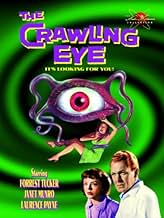VALUTAZIONE IMDb
5,2/10
5069
LA TUA VALUTAZIONE
Aggiungi una trama nella tua linguaA series of decapitations on a Swiss mountainside appear to be connected to a mysterious radioactive cloud.A series of decapitations on a Swiss mountainside appear to be connected to a mysterious radioactive cloud.A series of decapitations on a Swiss mountainside appear to be connected to a mysterious radioactive cloud.
Trama
Lo sapevi?
- QuizJohn Carpenter has said that this film, with its creatures hidden in the clouds, was partly the inspiration for his film Fog (1980).
- BlooperAfter Brett gashes his forehead in a fight, they discover he does not bleed and that he is already dead. Yet Professor Crevette gives Brett an inject-able sedative in the arm. No blood means there is no way for the drug to travel to his brain.
- Citazioni
Sarah Pilgrim: *Was* there an accident, Mister Klein?
Mayor Klein: O-On a mountain, uh, dese things sometimes happen.
- Curiosità sui creditiThe film's opening credits flash onto the screen when the passenger train rolls into the darkness of a tunnel.
- ConnessioniEdited into FrightMare Theater: The Crawling Eye (2017)
Recensione in evidenza
When I was very young, I viewed Quentin Lawrence's "The Trollenberg Terror" and Irving Pichel's "The Most Dangerous Game" quite often on late night TV. In retrospect, they are very hokey, but at such an impressionable age, these two films scared my sister and me a great deal. In fact, I think they marked us for life.
"The Trollenberg Terror," more often referred to as "The Crawling Eye" -- I love that name -- is about two psychic sisters in a remote ski resort who are terrorized by a giant, tentacled eye which uses the fog to hide its movements. The film climaxes with a King Kong-like finale involving the United Nations and an aerial battle with phosphorous bombs.
What more could you ask for in a cinematic experience? :) ... Except perhaps some better special effects. :p
"The Trollenberg Terror," more often referred to as "The Crawling Eye" -- I love that name -- is about two psychic sisters in a remote ski resort who are terrorized by a giant, tentacled eye which uses the fog to hide its movements. The film climaxes with a King Kong-like finale involving the United Nations and an aerial battle with phosphorous bombs.
What more could you ask for in a cinematic experience? :) ... Except perhaps some better special effects. :p
I più visti
Accedi per valutare e creare un elenco di titoli salvati per ottenere consigli personalizzati
- How long is The Crawling Eye?Powered by Alexa
Dettagli
- Data di uscita
- Paese di origine
- Lingue
- Celebre anche come
- The Crawling Eye
- Luoghi delle riprese
- Alliance Film Studios, St Margarets, Twickenham, Middlesex, Inghilterra, Regno Unito(studio: made at Alliance Film Studios Ltd)
- Azienda produttrice
- Vedi altri crediti dell’azienda su IMDbPro
- Tempo di esecuzione1 ora 24 minuti
- Colore
- Proporzioni
- 1.66 : 1
Contribuisci a questa pagina
Suggerisci una modifica o aggiungi i contenuti mancanti

Divario superiore
What is the Spanish language plot outline for I mostri delle rocce atomiche (1958)?
Rispondi


























